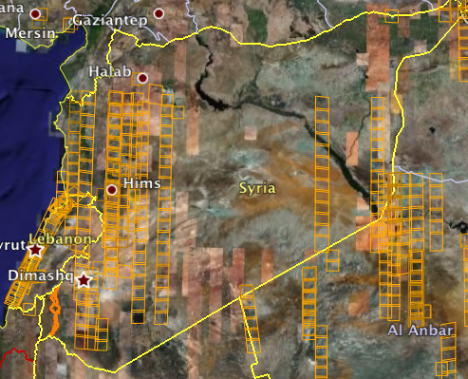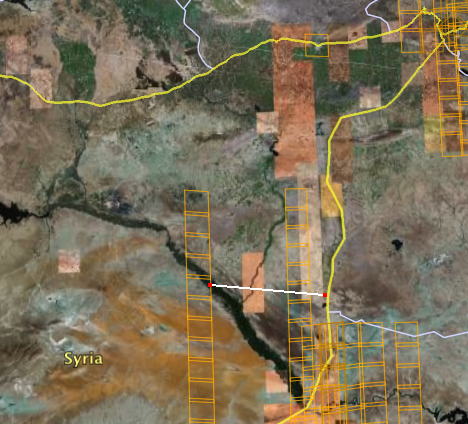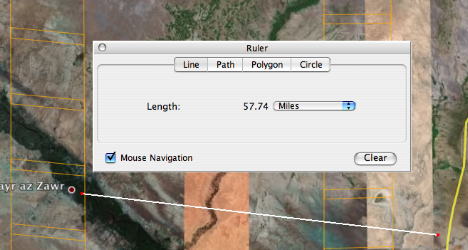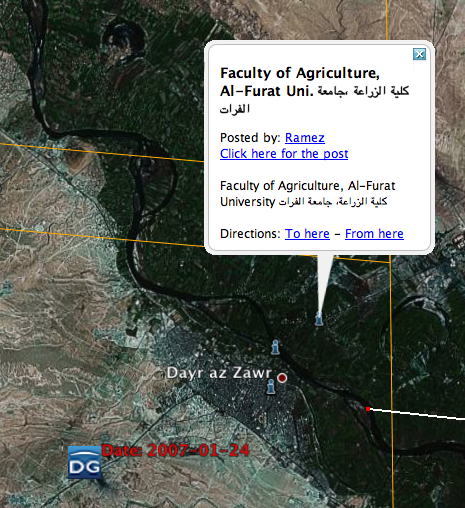Which installation did the Israeli bombing raid in Syria on September 6 target?
That question has been been on the minds of quite a few pundits since news outlets began reporting on the night-time raid by Israeli jets deep in Syrian territory. At first, very little was known, as sources were uncharacteristically mum. Slowly, it became apparent that there was a nuclear angle, and a North Korean angle.
Meanwhile, can we figure out from the available piece-meal evidence what precise location this raid might have targeted?
Blake Hounshell of Foreign Policy’s Passport blog was the first to have a go, using Google Earth, no less. His georeferencing hints came from this Times of London article:
An audacious raid on a Syrian target 50 miles from the Iraqi border was under way. […] The target was identified as a northern Syrian facility that purported to be an agricultural research centre on the Euphrates river.
Hounshell then extended a line 50 miles from the border along the Euphrates on Google Earth. The line ended in Al Mayadin, which alas is not in high resolution. Hounshell’s thesis was that an area of interest to western intelligence would have been imaged by the likes of DigitalGlobe, and that it would therefore be in high resolution in Google Earth. Because Al Mayadin wasn’t, Hounshell felt that his speculation was likely wrong.
I too went looking for the possible location, and found a good candidate, but didn’t feel there was sufficient circumstantial evidence to back up my speculation. Until tonight. Hounshell was closer than he thought.
What did I do? I triangulated three pieces of information.
1. I turned on the default Google Earth layer showing where DigitalGlobe’s imagery was taken in 2007. This most recent imagery is not yet in Google Earth, but you can tell from the layer what area was covered:

2. I assumed the 50-mile line was an approximation, probably converted from kilometers, and that the line from the border doesn’t have to follow the course of the Euprhates:


Putting these two pieces of information together, it looked like there was indeed a region about 50 miles from the border on the Euphrates where DigitalGlobe imagery had recently been taken.
3. I then turned on the full Google Earth Community layer and went looking for “agricultural research centers” in the area that might have been annotated by one of the 900,000+ contributors. I was surprised to find precisely what I was looking for:

Yes, there is an agricultural research center at Dayr az-Zwar, 50 miles from the Iraqi border, on the Euphrates, underneath a strip of recent DigitalGlobe imagery. Being the skeptical type, however, I felt that this was just too speculative, so I refrained from blogging it. But tonight, the Times of London actually names the town near where the raid took place:
Israeli special forces had been gathering intelligence for several months in Syria, according to Israeli sources. They located the nuclear material at a compound near Dayr az-Zwar in the north.
This latest article doesn’t mention agriculture (and nevermind that Dayr az-Zwar is not really “in the north” of Syria) but the ensemble of information I think now makes a pretty good case the the place that was bombed was a research center of Al-Furat University’s faculty of agriculture in Dayr az-Zwar.

(Bonus Syrian WMD geography lesson: Charles Levinson at Conflict Blotter links to a Jane’s Defence Weekly report about an explosion a few months ago at a “missile installation for manufacturing chemical weapons southeast of Aleppo”, at As Safirah. Interestingly, he notes:
I was surprised while reading today’s coverage to learn that [Israeli tabloid] Yediot Aharonot actually hires the Digital Globe, a commercial spy satellite, to photograph Syrian and Iranian military installations. Apparently they’ve been doing this for years.
That’s probably why you can see the location of this munitions factory in Google Earth in high resolution here.)
[Standard disclaimer: As much of the information above comes from intelligence sources leaking to the press, any or all of it may be wrong and intentionally misleading. Read critically!]
PS: I just thought about phoning the agricultural research center in Dayr az-Zwar/Deir EL-Zoor and asking them if they’ve had any bombing raids recently, but it’s very late there right now, and besides, that would be tantamount to actual reporting, which would go against the bloggers’ ethic:-)
What’s the relationship between the DG Coverage rectangles and imagery in GE? For an area in Iraq (Talafar), I turn on each DG yearly layer and see rectangles, but the imagery hasn’t changed in several years. It doesn’t look like any of the DG coverage for the last 6 years, for this area, has made it into GE. So, will the 2007 layer make it into GE? If so, when?
Ernie
I’ve just posted the location with a link to the before and after photos.
Any body know how much a raid like this costs the US taxpayer.In the past planes,training and munitions were paid for by the US TAXPAYER.These days even the aviation fuel is subsidised by the American taxpayer.
According to the Christian Science Monitor,the cost of Israel to the American TAXpayer has been over $1.6 TRILLION since 1973.http://www.csmonitor.com/2002/1209/p16s01-wmgn.html